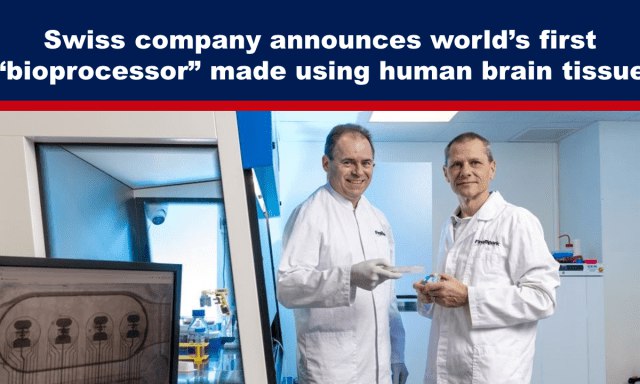A Swiss technology startup has just announced the world’s first “bioprocessor” constructed from 16 “human brain organoids.”
Without even knowing what any of that means, you can already tell this is bad. But you don’t know the half of it yet.
Recently corporate media has been running scare stories about artificial intelligence (“AI”) using massive amounts of energy. For example, last week Quartz wrote “Big Tech is turning to nuclear power because it needs more energy for AI.” The next day, The Guardian wrote that “Google’s emissions climb nearly 50% in five years due to AI energy demand.” And Fudzilla’s headline was even more dramatic: “AI’s energy appetite might kill the power grid.”
We know they use the Hegelian dialectic to manipulate public opinion; a problem is created, a reaction is generated, and then a solution is offered. And we know that they use the problem-reaction-solution process repeatedly to maintain control and influence over populations. So, ever since the scaremongering stories about AI needing massive amounts of energy started flooding the newsfeeds, as James Corbett said, we’ve “been bracing for impact.”
“After all, we know that hysteria campaigns are generally used to prepare the public for some horrible new “solution” that the technocrats have lying in wait for us,” he added.
“Well, guess what? That ‘solution’ is here, and it involves a computer made of living human brain tissue!”
The solution is provided by a Swiss startup called FinalSpark, which has launched the first online platform providing researchers access to a “living computer” made from brain “organoids.”
A brain organoid is a three-dimensional (“3D”) tissue derived from human embryonic stem cells or pluripotent stem cells, capable of simulating the architecture and functionality of the human brain. In other words, artificially grown, in a laboratory, human brain tissue.
FinalSpark published a paper in May about how its “Neuroplatform” has been constructed. The paper has the ominous title ‘Open and remotely accessible Neuroplatform for research in wetware computing’.
Wetware is a slang term that refers to biological software, which can include bio-implants, living neurons integrated into silicon chips, or even thought-controlled devices. To those who have already lost their humanity, wetware is the software that belongs to a living organism, such as the instructions contained within its DNA.
Wetware computing combines biology and computing to create a new type of computer system. Unlike traditional computers that rely on silicon-based hardware, wetware computers use living neurons and biological materials to perform computations.
In 2023, scientists from Johns Hopkins University (Baltimore, Maryland) and scientists from other universities in the US and Europe authored a roadmap for developing biocomputers from brain organoids.
“We call this new interdisciplinary field ‘organoid intelligence’ (OI),” Professor Thomas Hartung of Johns Hopkins University said. “A community of top scientists has gathered to develop this technology, which we believe will launch a new era of fast, powerful, and efficient biocomputing.”
As explained by eeNews, the 3D structure of brain organoids increases the culture’s cell density 1,000-fold, meaning that neurons can form many more connections. Also, brain organoids have a superior ability to store data.
“We’re reaching the physical limits of silicon computers because we cannot pack more transistors into a tiny chip. But the brain is wired completely differently. It has about 100 billion neurons linked through over 10^15 connection points. It’s an enormous power difference compared to our current technology,” said Hartung.
Read more: Roadmap shows how ‘wetware’ can power AI computers, eeNews Europe, 28 February 2023
A little over a year later, FinalSpark published its paper on the world’s first bioprocessor. The paper is full of jargon that is difficult for a layman to understand. Fortunately, Tom’s Hardware published an easier-to-understand article about FinalSpark’s Neuroplatform.
The operation of the Neuroplatform currently relies on an architecture that can be classified as wetware: the mixing of hardware, software and biology. The main innovation delivered by the Neuroplatform is through the use of four Multi-Electrode Arrays (MEAs) housing the living tissue – organoids, which are 3D cell masses of brain tissue.
Each MEA holds four organoids, interfaced by eight electrodes used for both stimulation and recording. Data goes to and fro via digital analogue converters (Intan RHS 32 controller) with a 30kHz sampling frequency and a 16-bit resolution. These key architectural design features are supported by a microfluidic life support system for the MEAs, and monitoring cameras. Last but not least, a software stack allows researchers to input data variables, and then read and interpret processor output.
World’s first bioprocessor uses 16 human brain organoids for ‘a million times less power’ consumption than a digital chip, Tom’s Hardware, 26 May 2024
Why do these scientists want to create computers out of living brain tissue? Because of “climate change” and energy efficiency.
FinalSpark says its Neuroplatform is capable of learning and processing information, and due to its low power consumption, it could reduce the environmental impacts of computing … FinalSpark claims that training a single LLM like GPT-3 required approximately 10GWh – about 6,000 times greater energy consumption than the average European citizen uses in a whole year. Such energy expenditure could be massively cut following the successful deployment of bioprocessors.
World’s first bioprocessor uses 16 human brain organoids for ‘a million times less power’ consumption than a digital chip, Tom’s Hardware, 26 May 2024
As James Corbett explains below, it gets worse.
Slaves in a Jar
The following is from the article ‘Scientists Create Organic Slave Computers! (What Could Go Wrong?)’ published by The Corbett Report on 7 July 2024.

OK, let’s recap: over the past month, the mockingbird media mouthpieces have begun warning in unison about a looming energy apocalypse as the AI industry begins consuming massive amounts of power. Then, out of the blue, a plucky Swiss tech startup (with private funders) arrives with a solution: a “Neuroplatform” that can save massive amounts of energy by using living human brain tissue to process information!
So far, so weird. But here’s where it gets creepy: when the FinalSpark brainiacs talk about using living human tissue to create this “bioprocessor,” that isn’t a figure of speech. The “brain organoids” used in this “living computer“ – developed, as their research paper tells us, “from Human iPSC-derived Neural Stem Cells” – are, in fact, alive.
This pesky little fact raises some deep moral quandaries – the type of “brain in a jar” ethical dilemmas that are, naturally, completely overlooked by the FinalSpark bioengineers and the fawning corporate press covering the story.
To wit:
- If these brain computers are in fact composed of living human brain tissue, do they count as living beings, with all the same rights and considerations we would extend to any other living creature?
- They can perform calculations and process information … so what if they’re sentient? Can they be aware of their surroundings? Do they feel pain or suffering?
- How are these living creatures made to do this computing, anyway? And what if these helpless slave computer brains – created in the lab for the sole purpose of processing information for their masters -didn’t want to do the scientists bidding?
Well, at least that final question has already been asked and answered, according to one recent report on FinalSpark’s Neuroplatform.
After accessing the provided login/password, researchers gain the ability to remotely send electrical signals to neurons and receive their responses. It is then the responsibility of researchers to devise optimal algorithms for controlling the behaviour of the organoids.
Users can mimic memory function by using periodic electrical stimulation to reinforce synapses through repetition, thus making desired pathways stronger.
Researchers do this by training the organoids through a reward system. The organoids are rewarded with dopamine, the neurotransmitter responsible for pleasure (and addiction).
Meanwhile, as “punishment,” the organoids are exposed to chaotic stimuli, such as irregular electrical activity.
Yes, you read that correctly. Stripped of all the niceties and polite circumlocutions, these researchers are alternately doping and torturing this brain tissue to force it to process information for them. If we consider for a moment that these lab-grown human brain organoids are in fact living creatures, then this entire system should be sending shivers down your spine.
In his own article on the subject, independent researcher Michael Snyder eschews the “organoids” euphemism and calls these beings what they are – “enslaved mini-brains.” He then puts this “reward and punishment” training system in its proper perspective:
If the enslaved mini-brains do what they are supposed to do, they are rewarded with lots of pleasure. If the enslaved mini-brains do not do what they are supposed to do, they are hit with lots of “irregular electrical activity.” In other words, these miniature human brains are tortured until they learn to obey. Reading that should literally make you sick. What these scientists are doing is so incredibly evil.
Amazingly, neither the FinalSpark scientists themselves nor the public relations men masquerading as pop-sci “journalists” have addressed these concerns or even shown any interest in the philosophical implications of growing living human tissue in a lab and forcing it to do their bidding.
If confronted, they would doubtless tell anyone with questions about this project to just relax! After all, these aren’t fully developed brains harvested from fresh human cadavers or anything like that. They’re just forebrain organoids (“Fos”) hooked up to electrodes on a “multi-electrode array” (“MEA”).
Look for yourself:

See? That’s nothing to get worked up about, is it?
But still, considering that these “forebrain organoids” are alive … does that mean they die?
Why, yes! Yes, they do die! But don’t worry, everyone, the FinalSpark team’s diligent efforts have greatly increased the lifespan of these biocomputers!
As the researchers themselves brag, while the initial lifespan of these biocomputers “was only a few hours,” they have – by implementing “various improvements” to the “microfluidics setup” – managed to extend this lifespan to “up to 100 days in best cases.”
Of course, FinalSpark fails to describe what exactly it does with these “organoids” after they die. But it doesinform us that, during the four years the Neuroplatform has been running, the enslaved mini-brains have been replaced 250 times. And, given that they have four of these human brainlets hooked up in their “multi-electrode array” at a time, “this amounts to testing over 1,000 organoids.”
If this isn’t the strangest and creepiest story you’ve encountered lately, then I don’t know what to say. But if you agree with me that this story is perverse, horrific and deeply disturbing, then you’d better prepare yourself. If the technocrats have their way, this is only the beginning.
The End of Vitalism?

It’s important to note that what FinalSpark is doing is not some fringe, ghoulish scientific anomaly. It’s not some strange outlier dreamed up by a band of mad scientists. In fact, it’s not even a new idea.
As it turns out, there is an entire field of computing called “wetware computing” that concerns itself with finding ways to use organic material to process information. The first example of this “living computer” idea was constructed in 1999 when Professor Bill Ditto at the Georgia Institute of Technology created a “novel calculator” – dubbed the “leech-ulator” – which used leech neurons to perform simple calculations. Ditto insisted the idea was revolutionary because ordinary computers have to be told exactly what to do whereas bioprocessors can work it out for themselves. Blessed with its natural, organic intelligence and problem-solving abilities, these “living” computers can even derive correct answers from partial or faulty data inputs.
“Ordinary computers need absolutely correct information every time to come to the right answer,” he says. “We hope a biological computer will come to the correct answer based on partial information, by filling in the gaps itself.”
And that was 25 years ago. Since then, we have seen the advent of computers made from human brain cells that can perform voice recognition. And a cluster of human brain cells on a computer chip that have been trained to play the “Pong” video game. Now that Neuroplatform is available for researchers to play around with, who knows what these geniuses will come up with next?!
So, what would you get if you put one of these “living computers” into a cyborg exoskeleton covered in living human skin?
That may seem like the type of question that is confined to the purely hypothetical realm – fodder for some wacky sci-fi writer with an overactive imagination, perhaps – but it isn’t. As we’ve already seen, “living computers” using human brain tissue to make calculations are already here. And guess what? Living skin for robots is already here, too.
Just last month, it was announced that “[a] team of scientists at the University of Tokyo has developed a robot face covered with self-healing, lab-grown skin that can mimic human expressions.”
Now just imagine if an organic slave computer brain was put into a robot covered in that self-healing, lab-grown, human-expression-mimicking skin. And now imagine if that robot looked like the truly skin-crawling (pun intended) Disney animatronic robot.

(Yes, the Disney robot is really a thing, and it’s even more disturbing when you see it in motion.)
So, let’s answer that question. What would you get if you put an organic slave computer inside such a skin-covered, animatronic robot?
The answer is tricky. You certainly wouldn’t have a human. But you wouldn’t exactly have a robot, either. And that is exactly the point.
You might recall my coverage of the “biodigital convergence” from three years ago. If not, please go back and re-read that article or re-watch that podcast to re-familiarise yourself with the crazy Canadian government think tank report on how “biological and digital systems are converging” and how this convergence “may transform the way we understand ourselves and cause us to redefine what we consider human or natural.”
When you do so, please notice how I made special note of this passage from that document:
As we continue to better understand and control the mechanisms that underlie biology, we could see a shift away from vitalism – the idea that living and non-living organisms are fundamentally different because they are thought to be governed by different principles. Instead, the idea of biology as having predictable and digitally manageable characteristics may become increasingly common as a result of living in a biodigital age. Any student of biology today will have grown up in a digital world and may consciously or subconsciously apply that frame of reference to bioinformatics and biology generally.
As I noted at the time, this is one of the linchpins of the entire transhumanist agenda. Just as the central bank digital currency paradigm and the complete control of our digital life is predicated on the digital ID system, so, too, is the transhumanist dream of merging man with machine predicated upon a breakdown in our philosophical intuition of vitalism. In other words, to get us to accept the coming transhuman dystopia, the technocrats are going to have to break down our fundamental, deeply-held belief in the difference between living, organic matter and inanimate non-life.
That sense of vitalism is precisely why we find organic slave computers with living human skin and animatronic robots with realistic facial expressions so profoundly creepy. These technologies start to challenge our belief in the boundaries between life and non-life.
Now, there is one hopeful thing in all of this: if you still do feel that sense of creepiness when you think about or read about or see this technology, then that is a good thing. That means you still have your head screwed on straight even in the face of so much propaganda designed to convince us to give in to the Trans(human) Agenda.
Embrace that feeling of creepiness. Do not lose your sense of disgust at this technology. You will need to cling on to that so that you can forcefully and powerfully reject this technology and everything and everyone associated with it. Those who are seeking to break down this distinction and desensitise us to this “living” computer idea are our ideological enemies. If we ever stop seeing them as the enemy in this struggle, that is when we lose our humanity altogether.
Having said that, this is not some theoretical warning about some far-off, hypothetical threat. It is here. Now. These technologies already exist.
Creepy Disney robots.
“Self-healing” cyborgs covered in lab-grown living skin.
And, of course, organic slave computers.
Welcome to the world of 2024, everyone! God help us all.
Source: https://expose-news.com/2024/07/09/bioprocessor-made-using-human-brain-tissue/
Bitchute: https://www.bitchute.com/channel/YBM3rvf5ydDM/
Telegram: https://t.me/Hopegirl587
EMF Protection Products: www.ftwproject.com
QEG Clean Energy Academy: www.cleanenergyacademy.com
Forbidden Tech Book: www.forbiddentech.website













